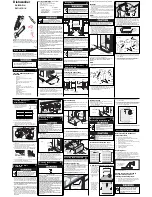
– 3 –
3. Con rm consumer is using the correct amount
of
HE
detergent. Refer to
HE
detergent package
label for correct detergent amounts for partial
and full loads. Less
HE
detergent is required
for soft/softened water and/or partial loads.
Con rm clothes loads of similar fabrics and
reasonable size.
A reasonable load size is up
to one full laundry basket (about 16 lb of dry
clothes).
Some loads cause more vibration (rugs,
towels, jeans, etc.) than others. For example,
washing only a few towels alone can cause an
unbalanced load because they soak up water
and concentrate weight in only one part of the
basket.
Note:
The following diagnosis steps apply
to all units (both pedestal and nonpedestal
installations).
4.
Four on the oor
- ensure the unit is level and
all four leveling legs are properly adjusted and
securely on the oor. The objective is for each
of the four legs to carry equal weight; four on
the oor.
As little as 1/4 or 1/2 turn on a single
leveling leg can be signi cant.
A helpful quick
check is to place your left hand on the top left
front corner and your right hand on the top
right rear corner. Then, push the washer in the
direction of your hands and note force required
to remove the weight from the front leg. Now,
reverse hands, i.e., right in top right front corner
and left in top left rear corner, and note the force
required to remove weight from the front leg.
The two forces should be equal.
5. With basket empty of clothes and water, run the
T14 test and check for acceptable vibration or
movement. To run T14, press the
Power
button
to clear any current cycles. (The display must be
blank to proceed.) Press the
Extra Rinse
button,
press the
Delay Start
button, press the
Extra
Rinse
button again, then press the
Delay Start
button again. When con gure
UI
comes up on
the display, rotate the
Cycle Select
knob until
T14
is displayed, then press the
Start
button.
Note the test does not rebalance the load. Press
Power
to quickly end the test for an extreme
out-of-balance condition. Once the unit reaches
410 rpm, press the
Start
button again, the
washer will then ramp up to 1050 rpm. Pressing
Start
again ramps up to 1150. Press
Start
again
and the washer ramps to 1300 rpm.
4. Ensure rear legs are level and rear jam nuts
are wrench tight against washer or pedestal
bottom (
see picture below)
. Next, run T14 Spin
Test and adjust front legs for minimum vibration
or movement at ~ 400 rpm. Secure the front
jam nuts wrench-tight and run Spin Test again
to con rm legs are set properly for minimum
vibration or movement while washer is spinning
at 400 rpm. Press on the washer top left front
corner toward the top right rear corner with
your hands and note if there is any increased
vibration. Then, press on top right front corner
toward the top left rear corner with your hands
and note if there is any increased vibration.
If pressing either corner
decreases/lessens
vibration or movement, the legs are still out of
adjustment and must be corrected. If pressing
either corner
increases/worsens
vibration or
movement, the legs are properly set.
6. Exit Diagnostic Mode, open door, and place 1
or 2
dry
, tightly rolled up, bath towels in basket
and tape in place to a baf e inside against the
basket, centered front to back
(see picture).
The
weight of the towel(s) should be about 1-1.5 lb;
do
not
exceed 2 lb. This test simulates an out of
balance load to make checks and adjustments
minimizing vibration and movement.
Note:
Up to 1/4-inch movement is normal
operation. If okay, proceed to step B. If not okay,
adjust legs and/or check for a machine structural or
mechanical fault (see next Section).






















